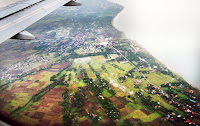Photos and Verses by Abe V Rotor
 Biggest spotlight - the sun - reveals a typical farming community, the fields
basking with the golden color of grain and color of the earth after harvest.
Biggest spotlight - the sun - reveals a typical farming community, the fields
basking with the golden color of grain and color of the earth after harvest.

Geometric parcels of farmland in parallel formation apparently
show diversified farming and system of crop rotation.
It's the peak of summer, and the rains have not arrived. Green patches are fields irrigated from shallow wells.
Residential houses huddle on one side of a creek (left); farms
undergo fallowing, a resting period in summer.
Misty air looms over the dry landscape - a prelude to monsoon
This fringe of land appears to have a sub-climate of its own influenced by the surrounding sea, while the rest of the island undergoes the normal dry season.

The uplands were once covered with forests and grasslands,
now converted into agriculture and settlements. 
A wisp of smoke greets the lazy morning air from among
the trees that line a creek appearing like a miniature forest. 
A unique symmetry created by a natural waterway crowded with trees that form a natural windbreak and sanctuary of surrounding organisms specially in summer.
Take me for a moment away from you, Mother Earth,
higher than the highest mountain, the tallest building,
that I may view life whole and solid and unabridged
in a perspective beyond details, and without stirring:
I see clouds shrouding you from the sun and blue sky,
in cumulus like giant mushroom on the horizon, rising,
and released into nimbus, becoming heavy, falling as rain
in the accompaniment of wind, thunder and lightning.
I see rivers swell and lakes fill to the brim in monsoon,
flooding fields and pasture, spilling through the valley,
meandering, roaring over waterfalls and boulders,
resting in swamps and estuaries, then flowing to sea.
I see farmers in the field, women and children, too,
and work animals pulling the plow and the harrow;
I hear singing and laughter and joyous conversation,
barking of dogs, cackling of fowls trailing the furrow.
I see harvesters gather the golden grains by hand;
drying shocks in the sun, and building haystacks;
I see flocks of pigeon and native chicken gleaning,
women and children, the sun setting on their backs
I see the fields scorched, a smoke here and there -
bush fire! when the grass dries up bursts into flame
spreading all over, burning anything on its path -
what a waste! but it is nature's work and game.
I see poor harvest, good harvest, where and why,
crops early or late, and fields never planted at all;
I see farming a way of life, farming as a business,
and farm life in all seasons, happiness is its goal.
I see children flying kites of various makes and colors,
beside them grownups cheering, coaching, flying
their own kites too, oh, they have not forgotten
the art of their childhood, so do I, reminiscing.
I see children playing patintero, trompo and sipa,
games of old folks when they too, were children;
games of beetles and spiders as gladiators;
palo de sebo and pabitin can not be forgotten.
I see tourists, I see balikbayan, I see old and young;
familiar and unfamiliar faces, sweet, shy, and bold;
I see children going to school, housewives to market,
people of all walks of life, always on the move.
I see the hills and mountains, to me they're the same,
but where have the forests gone, the pasture?
I see the rivers, the lakes and ponds old as they are,
I have always loved all of these as I love nature.
I have seen enough, let me return, Mother Earth,
to my home, sweet home, on the farm, to my family;
and tell them of what I've seen in my short sojourn,
down below I see my friends, my neighbors, and me. ~





.jpg)


.jpg)
































